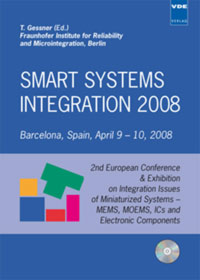Innovative micropower solutions for Wireless Autonomous Sensor Nodes
Konferenz: Smart Systems Integration 2008 - 2nd European Conference & Exhibition on Integration Issues of Miniaturized Systems - MOMS, MOEMS, ICS and Electronic Components
09.04.2008 - 10.04.2008 in Barcelona, Spain
Tagungsband: Smart Systems Integration 2008
Seiten: 4Sprache: EnglischTyp: PDF
Persönliche VDE-Mitglieder erhalten auf diesen Artikel 10% Rabatt
Autoren:
Altena, G.; Vullers, R. J. M.; Pop, V. (Holst Centre / IMEC-NL, Eindhoven, the Netherlands)
Sterken, T. (IMEC vzw, Leuven, Belgium)
Puers, R. (ESAT, KU Leuven, Leuven, Belgium)
Inhalt:
Low-power is one of the key demands for wireless autonomous sensor nodes. This demand has motivated industry and research institutes to work on various advanced systems that can efficiently deliver power to demanding applications. This paper deals with energy harvesters and energy storage systems as important building blocks for such sensor nodes. Energy harvesting is the process of converting unused ambient energy into usable electrical power. As these energy harvesting devices shrink in dimension, while still providing sufficient energy, they will be key enablers for autonomous wireless transducer systems. For such purposes, harvesting devices designed for a footprint of 1 cm2 and an average power harvesting level of 100 microwatt are being investigated. The power module will convert the highly irregular energy flow from the energy harvester further into regulated energy suitable to charge an energy storage device, e.g. battery or ultracapacitor, or to directly power the wireless autonomous sensor network modules. In such a module, the battery’s basic task is to store energy obtained from the harvester and to release it to the load when needed. A complete wireless autonomous node has more functional blocks besides a micropower module. A sensor device will capture the required physical or chemical parameter. The Analog-to- Digital and signal processor will be used for transforming the measurements into (processed) digital information. A radio module will allow communication with external receivers. The focus in this paper will be on the micropower module, consisting of the harvester and the energy storage functions.


